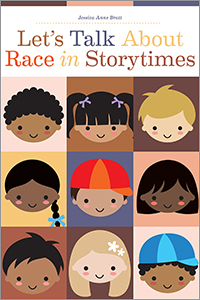"Diversity of identities should be a celebration, not a burden": an interview with Jessica Anne Bratt
Children's librarians are taking seriously our profession’s calls for equity, diversity, and inclusion (EDI). They already know that popular storytimes can be an effective way to increase  community representation and belonging at the library. Talking about race in storytimes is an ideal way to foster inclusion by normalizing conversations about these issues, and Jessica Anne Bratt's new book shows how to do just that. Inside, she offers adaptable storytime activities, tools for self-reflection, and discussion starters. In this interview she talks about the genesis of the book, the reasons that self-reflection work is so important, and what gives her hope for the future of librarianship.
community representation and belonging at the library. Talking about race in storytimes is an ideal way to foster inclusion by normalizing conversations about these issues, and Jessica Anne Bratt's new book shows how to do just that. Inside, she offers adaptable storytime activities, tools for self-reflection, and discussion starters. In this interview she talks about the genesis of the book, the reasons that self-reflection work is so important, and what gives her hope for the future of librarianship.
Congrats on the new book! In your Preface, you write, "I’ve always talked about race and diversity during storytimes and would celebrate them. I didn’t realize this approach was unique." When did you decide that you wanted your storytimes to grow into something larger and use them as the basis for a book?
After listening to Charlene Carruthers speak around how everyone can use their skills and talents to bend the arc toward justice. I wanted to lay the groundwork on how other people could talk about race in a respectful way, especially when dealing with diverse communities. I would witness people attending EDI training unsure or overwhelmed at how to put what they learned into practice.
You also write, "All the collected knowledge in the world will not help you move forward on your journey if you do not take a step. Self-work is the first step needed to engage in this work to bring it to the community around you." Describe the worksheets and self-reflection questions in your book and what they're designed to do.
Not to make an overgeneralization, but a really good EDI facilitator once told me that you cannot engage in this work wounded or lost. If you do not understand yourself, your identities, then how can you help empower others to navigate their identities and/or children identities? Furthermore, some people have a lot of trauma around their own identities, and you cannot do this work unless you are healed whether you have trauma around oppressing others or being oppressed. This work cannot be done self-righteously, and the way to do that is to focus on yourself before you practice it on others.
What advice can you give to librarians who may feel uncomfortable talking about race in their storytimes?
 At this age, diversity of identities should be a celebration, not a burden. Furthermore, a lot of times as adults, we internalize our own childhood and/or adult baggage on how we would interact with children or have fear of what adults would say. This work has layers; and there’s representation, which is the first step. Then adding on the layer of learning how to talk about racial identities—it comes from a place of providing tools for kids around understanding differences and showing respect to others when confronted with those differences.
At this age, diversity of identities should be a celebration, not a burden. Furthermore, a lot of times as adults, we internalize our own childhood and/or adult baggage on how we would interact with children or have fear of what adults would say. This work has layers; and there’s representation, which is the first step. Then adding on the layer of learning how to talk about racial identities—it comes from a place of providing tools for kids around understanding differences and showing respect to others when confronted with those differences.
You include a number of advocacy talking points centered on social justice. What gives you hope for the future of the profession?
I feel that we are embarking on a journey of new librarianship—that is, acknowledging the importance within communities to be spaces where learning through conversation is powerful. In order to do that well, librarians are equipping themselves with all different skill sets in order to provide support and enrichment within their communities.
Learn more at the ALA Store.
